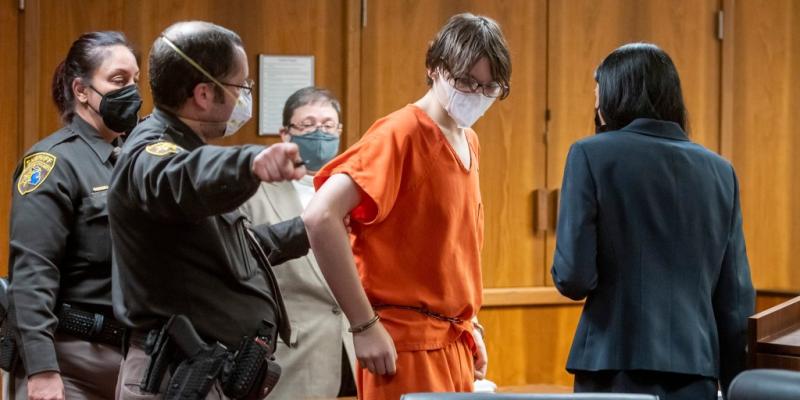Prosecutors fight to keep Michigan school shooting suspect, 15, in adult jail



The 15-year-old accused in the deadly mass shooting at his suburban Detroit high school in November should be kept in adult jail as he awaits trial, prosecutors said Tuesday.
Oakland County Assistant Prosecutor Kelly Collins said during a hearing about the teenager's confinement that he's demonstrated he can be calculating, has a desire to be remembered for his alleged crimes, and enjoys the notoriety the case has brought him, including email from women.
"How to do I get my fan mail, how do I get my hate mail"? he has said, according to Collins.
He has "a deeper and more calculated mind than any other 15-year-old," she argued in court.
The teenager's defense team formally asked the court that he be transferred from Oakland County jail to Children's Village in Pontiac.
Collins said the teen already killed four classmates atOxford High School on Nov. 30 and that teenagers at the juvenile facility would be put in danger that is "contrary to the rehabilitation of those at Children's Village."
"He enjoyed his dark side," Collins said. "He's fascinated with violence."
The teenager's defense team said he's hardly been in direct contact with anyone, except his lawyers, since he's been in jail, despite a possible need for psychiatric supervision.
"The jail is not equipped with handling juveniles," attorney Paulette Loftin said during the hearing.
She said he was removed from "constant watch" in jail. His lawyers indicated in a court filing they plan to pursue an insanity defense.
Because the defendant had no prior criminal or disciplinary school record to speak of, Loftin said, he should be allowed to wait for trial in the children's facility with defendants his age.
Loftin argued that because many of the people sending him email are women, such communication could be better supervised if he was held at Children's Village.
"These are emails from strangers all around the world," Loftin said. "At Children's Village we are able to control that communication."
Loftin did not immediately respond to a request for comment Tuesday night.
Judge Kwame Rowe said he would make a decision in the upcoming days.
The suspect, Ethan Crumbley, has pleaded not guilty to two dozen charges, including murder. His parents are also being jailed on four counts each of involuntary manslaughter in the shooting. They have pleaded not guilty to the charges.









That kid and his parents are most likely certifiably looney toons and need to be locked up in a mental institution.
A problem with mail is not an excuse to put the children at Children's Village in the path of harm's way by allowing this volatile pos among them. Keep this animal in adult jail where others won't take his shit.
Without a doubt he should not be around any children. He already proved he is capable of killing them.
Unfortunately, the prosecutor is wrong, wrong, wrong. It could be that one (or more) percent of 15 year olds have an identical mind.
Although the research is evolving, the theory that I have most often read is that psychopaths are born and sociopaths are made.
I was curious and googled "at what age does psychopath symptoms surface".
I cherry picked an overview of an interesting and chilling article.
more....
My thought is that some people are just damaged. There is no help for some.
Who in the word are these women that would email him and write him letters.
The same kind who sent Richard Ramirez, Ted Bundy, Manson, and every other serial killer love letters and marriage proposals.....total brain dead and warped women.